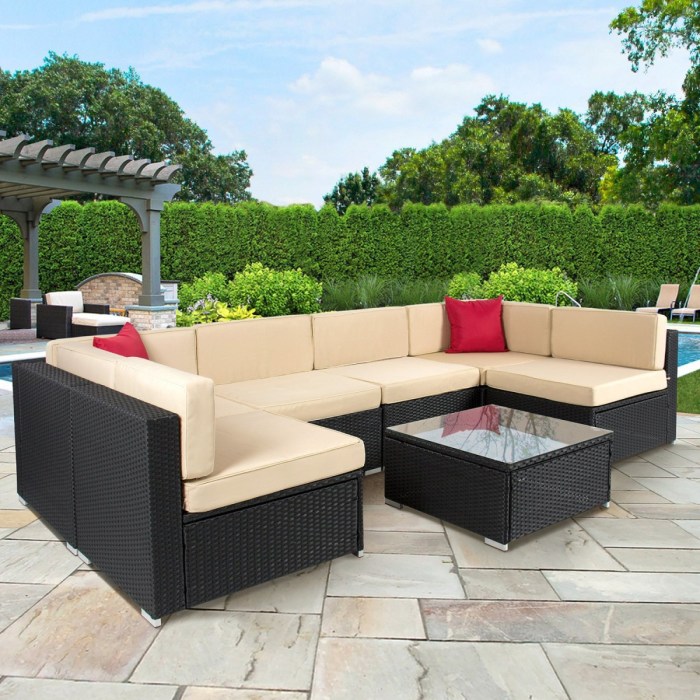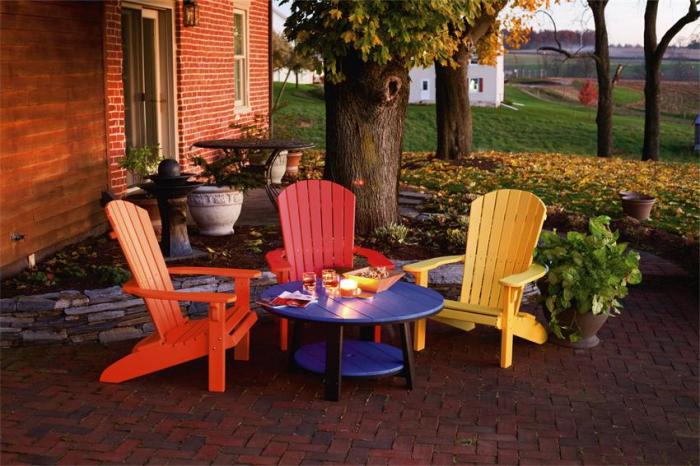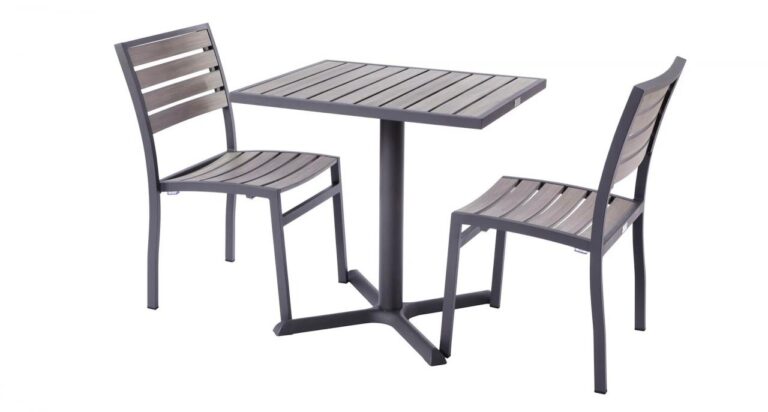Commercial Outdoor Patio Design Essentials
Commercial outdoor patio design is key to boosting business success. From restaurants to hotels, creating inviting and functional outdoor spaces is crucial for customer experience and profitability. This guide explores the essential elements for crafting a successful commercial outdoor patio, covering design considerations, construction, furniture, amenities, and legal aspects. A well-designed space can transform a business, increasing customer satisfaction and ultimately driving revenue.
This comprehensive overview delves into the multifaceted world of commercial outdoor patios, examining various facets from initial definition and design to construction, maintenance, and the integration of key features. Understanding these aspects is crucial for businesses seeking to enhance their outdoor offerings and maximize customer engagement.
Defining Commercial Outdoor Patios
Commercial outdoor patios are extensions of indoor spaces, designed to create inviting and functional outdoor environments for various commercial ventures. They offer a unique opportunity to maximize customer experience, boost revenue, and create a distinctive atmosphere. From bustling restaurants to serene hotel lobbies, these outdoor areas are meticulously crafted to complement the overall brand image and operational needs.
Commercial outdoor patios differ significantly from their residential counterparts in terms of scale, functionality, and design considerations. The primary focus is on accommodating large groups, managing high traffic flow, and ensuring safety and accessibility for a broader clientele. Regulations and building codes often play a crucial role in their design and construction, requiring compliance with local ordinances and safety standards.
Types of Commercial Outdoor Patios
Commercial outdoor patios are diverse in their application and design. They can be found in a variety of commercial settings, including restaurants, bars, hotels, cafes, and entertainment venues. Each type often features design elements specific to its function. For example, a restaurant patio will prioritize seating arrangements conducive to dining, while a hotel patio might focus on relaxation and socializing.
Key Characteristics of Commercial Outdoor Patios
Commercial outdoor patios are characterized by several key elements that differentiate them from residential patios. These patios are designed to handle a higher volume of people and traffic, often accommodating large groups for dining, socializing, or entertainment. Furthermore, they are built to meet specific safety standards and regulations, often exceeding the requirements for residential spaces. This typically involves reinforced structures, accessibility features, and compliant lighting systems.
Design Elements of Commercial Outdoor Patios
The design of a commercial outdoor patio is crucial in creating an inviting and functional space. Seating arrangements are carefully considered, typically with multiple configurations to accommodate different group sizes and dining styles. For instance, booths, tables, and bar seating are common elements. Lighting is essential to provide both aesthetic appeal and safety, often using a combination of ambient, task, and accent lighting. Landscaping plays a crucial role in creating a welcoming ambiance, with appropriate plant choices, pathways, and décor.
Functions of a Commercial Outdoor Patio
Commercial outdoor patios serve a variety of functions, each tailored to the specific needs of the business. These functions are crucial for attracting customers, fostering a sense of community, and generating revenue.
- Dining: Patios are frequently used for dining, with tables and seating arrangements optimized for enjoying meals in an outdoor setting. This extends the dining area beyond the confines of the interior space.
- Socializing: Many commercial outdoor patios are designed to encourage social interaction, with seating arrangements and features that promote conversation and mingling. Outdoor seating areas can provide a more relaxed and welcoming atmosphere than the interior.
- Entertainment: Some commercial outdoor patios are designed for entertainment, hosting events such as live music performances, outdoor movie screenings, or other activities. This is often seen in bars, restaurants, and entertainment venues.
Design Considerations
Creating a successful commercial outdoor patio hinges on careful consideration of various factors. A well-designed patio not only enhances the aesthetic appeal of a business but also contributes to customer satisfaction, safety, and profitability. Careful attention to detail, from climate adaptation to accessibility, is crucial to creating a space that resonates with the target audience and fosters a positive experience.
Environmental Factors
Climate plays a significant role in patio design. Consider the prevailing weather patterns, including temperature extremes, rainfall, and potential for severe weather events. A patio designed for a region with hot summers might incorporate shaded areas, misting systems, or retractable awnings. Conversely, a patio in a region with frequent snowfall or rain may need to feature waterproof materials, enclosed seating areas, or a covered outdoor dining space. Zoning regulations also influence patio design. Local ordinances often dictate the permissible size, height, and construction materials. Compliance with these regulations is essential to avoid penalties and ensure smooth construction and operation.
Accessibility and Safety
Ensuring accessibility for all customers is paramount. The design must adhere to accessibility guidelines, incorporating ramps, wider doorways, and accessible restrooms if needed. Safety is equally crucial. Proper lighting, clear pathways, and sturdy furniture are vital elements. Adequate lighting is essential for visibility, particularly in the evening hours, while well-maintained pathways ensure customer safety during their experience. Furniture selection should prioritize durability and stability to prevent accidents.
Design Styles and Materials
Various design styles can be implemented to suit different business types. A modern patio might feature clean lines, minimalist furniture, and contemporary materials like glass and steel. A rustic patio might incorporate natural elements like wood, stone, and wrought iron, while a contemporary patio could integrate innovative lighting and landscaping. Material selection should consider durability, weather resistance, and aesthetic appeal. For example, treated lumber is a popular choice for decking due to its durability and affordability. Durable, stain-resistant fabrics are best for outdoor cushions and seating.
Outdoor Amenities and Features
Incorporating outdoor amenities can significantly enhance the customer experience. Fire pits offer a warm and inviting ambiance, especially during cooler evenings. Water features, such as fountains or small ponds, can add a calming and tranquil touch. Outdoor kitchens provide a convenient space for food preparation and entertainment, increasing the overall appeal of the patio. Consider the size of the space and the specific needs of the business when choosing amenities. A restaurant might benefit from an outdoor kitchen, while a bar might prioritize a fire pit and comfortable seating areas.
Construction and Maintenance

Source: glamour.com
Building a robust and attractive commercial outdoor patio requires careful planning and execution throughout the construction and maintenance phases. This section details the key considerations for creating and preserving a high-quality outdoor space that stands the test of time.
A well-constructed commercial patio enhances the business’s appeal, creating a welcoming and functional space for customers and employees. Proper maintenance ensures longevity and aesthetic appeal, minimizing costly repairs and maximizing the patio’s lifespan.
Construction Methods
Various construction methods are available for commercial outdoor patios, each with unique characteristics. Paving options, such as concrete or paver stones, provide durable and low-maintenance surfaces. Decking, typically made of wood, composite materials, or metal, offers a warm and inviting aesthetic, but requires more regular upkeep. Landscaping plays a critical role in enhancing the overall design, incorporating greenery, water features, and other elements to create a cohesive and visually appealing space. Proper selection of materials is vital for the long-term success and sustainability of the patio.
Construction Process
The construction process for a commercial outdoor patio involves several key steps. First, meticulous site preparation is essential, involving clearing the area, grading the ground to ensure proper drainage, and installing any necessary utilities. Next, the chosen construction method dictates the specific installation steps, which may involve pouring concrete, laying pavers, assembling decking components, or installing landscaping features. A comprehensive plan, including detailed blueprints and material specifications, is critical to a successful project. Thorough inspections at each stage are vital to guarantee quality control and adherence to safety regulations. Finally, meticulous attention to detail during the finishing touches stage, including the installation of lighting, furniture, and any decorative elements, is critical for achieving the desired aesthetic and functionality.
Permits and Approvals
Obtaining necessary permits and approvals is crucial for any commercial construction project. The specific requirements vary based on local regulations and building codes. Consult with local authorities to determine the necessary permits and approvals before commencing construction. This proactive approach minimizes potential delays and ensures the project’s compliance with all legal requirements. The process may involve submitting detailed plans, obtaining necessary inspections, and adhering to specific timelines.
Maintenance Tasks
Regular maintenance is essential for preserving the beauty and longevity of a commercial outdoor patio. A proactive approach to upkeep can significantly extend the patio’s lifespan and minimize costly repairs. Routine cleaning and sealing, depending on the materials used, are crucial for maintaining the patio’s aesthetic appeal. Regular inspections for damage or wear and tear are also vital. Proper maintenance minimizes potential hazards, such as tripping risks and structural issues. This proactive approach contributes to the safety and functionality of the patio.
Furniture and Patio Element Maintenance
Maintaining outdoor furniture and other patio elements requires specific care to preserve their condition and appearance. Outdoor furniture, especially wooden or metal pieces, needs regular cleaning and protection from the elements. Follow the manufacturer’s instructions for the best results. Cleaning and protection of these elements will maintain the patio’s overall aesthetic appeal. Regular inspection of furniture for damage or wear is important. Protecting furniture from harsh weather conditions is crucial for extending its lifespan.
Commercial Outdoor Patio Furniture

Source: premierbackyardliving.com
Selecting the right furniture is crucial for a successful commercial outdoor patio. The furniture should not only enhance the aesthetic appeal but also withstand the elements and meet the needs of the patrons. Durability, comfort, and accessibility are key considerations.
Common Furniture Types
Commercial outdoor patios utilize a variety of furniture to accommodate different activities and patron needs. Tables, chairs, and sometimes sofas or lounge seating are common choices. The specific types and quantities depend on the intended use of the space. For instance, a restaurant might feature more tables and chairs than a cafe with a focus on lounging.
Features and Characteristics for Commercial Use
When selecting outdoor furniture for commercial use, several key features are paramount. Durability is essential to withstand heavy use and exposure to the elements. Comfort is crucial to ensure patrons enjoy their time outdoors. Proper design and ergonomics play a vital role in comfort. Consideration should also be given to easy maintenance and cleaning. Weather resistance is critical, particularly in areas with significant temperature fluctuations or inclement weather.
Material Comparisons
Various materials are used in outdoor furniture. Wood, metal, and wicker are common choices, each with its own strengths and weaknesses. Wood, while often aesthetically pleasing, requires regular maintenance and can be susceptible to damage from moisture and pests. Metal furniture is generally more durable and weather-resistant, but can sometimes feel less comfortable. Wicker, a synthetic material, offers a balance between durability and aesthetic appeal, often with UV resistance. The choice of material should be based on the specific needs of the space and budget constraints.
Durability and Weather Resistance Requirements, Commercial outdoor patio
Commercial outdoor furniture needs to meet stringent durability and weather resistance standards. Furniture should be able to withstand frequent use, exposure to sunlight, rain, and temperature changes. High-quality materials, reinforced construction, and protective finishes are essential to ensure longevity. Consider using furniture rated for specific weather conditions to guarantee durability. Look for furniture that is treated against pests, moisture, and UV damage.
Restaurant Patio Table Layout (Example)
A table layout for a restaurant patio needs to accommodate the expected number of patrons while considering accessibility. For a patio designed to hold 60 patrons, the following layout is a suggestion:
| Table Type | Number of Tables | Seating per Table | Total Seating |
|---|---|---|---|
| Round Tables | 12 | 4 | 48 |
| Rectangular Tables | 18 | 6 | 108 |
| Large Modular Tables | 6 | 8 | 48 |
This layout provides a mix of table sizes and configurations. It should be designed to accommodate wheelchairs and other mobility devices. Paths and walkways between tables should be wide enough for easy movement and access. The spacing between tables should be sufficient for comfortable dining and maneuverability. It’s crucial to have designated areas for restrooms and service areas with clear pathways. Adequate lighting and signage should also be provided for safety and convenience.
Amenities and Features: Commercial Outdoor Patio
Enhancing a commercial outdoor patio experience involves thoughtful consideration of amenities and features that cater to the needs and desires of patrons. Careful planning ensures a welcoming and engaging environment, increasing customer satisfaction and fostering a positive brand image. Well-designed amenities contribute to a memorable experience, influencing customer perception and potentially driving business growth.
Adding amenities and features to a commercial outdoor patio goes beyond mere aesthetics. It’s about creating a functional and enjoyable space that caters to diverse needs, attracting a wider range of customers. These elements can transform a simple patio into a vibrant hub, enhancing its appeal and practicality.
Lighting Design
Proper lighting is crucial for creating a welcoming ambiance and ensuring safety at night. Different lighting styles can be strategically employed to highlight specific areas, set a mood, and guide customers through the space. Soft, warm lighting enhances the atmosphere, while task lighting illuminates walkways and seating areas. Exterior lighting should comply with local regulations and safety standards, ensuring visibility and minimizing glare. Consider using LED lights for their energy efficiency and longevity. Examples include pathway lighting, accent lighting for landscaping features, and ambient lighting for overall illumination.
Shade Structures
Shade structures offer protection from the sun, extending the usability of the patio throughout the day. They are essential in maintaining comfort and preventing discomfort from extreme heat. The design of shade structures should complement the overall patio aesthetic. Different materials, styles, and sizes can be employed to achieve the desired effect. Consider retractable awnings for flexible shade coverage, or permanent shade sails for a more permanent solution. Additionally, consider pergolas or covered patios for a more sophisticated and structured look.
Restrooms and Accessibility
Providing restroom facilities is a necessity for commercial outdoor patios, especially those catering to large groups or extended use. These facilities should be clean, well-maintained, and accessible to all patrons. Accessibility features are critical in accommodating individuals with disabilities, fostering inclusivity and compliance with accessibility regulations. Ramp access, accessible restrooms, and tactile paving are important considerations. Consult with accessibility experts to ensure compliance with ADA guidelines and regulations. For instance, a commercial patio in a park or public space will likely need more comprehensive accessibility features.
Technology Integration
Integrating technology into the design enhances the overall customer experience and streamlines operations. Wi-Fi access provides convenience for customers using their devices. Charging stations for mobile devices are also a must, catering to the needs of customers and staff alike. These additions can contribute to a more comfortable and convenient experience. For example, consider integrating digital menu boards for ordering or reservation systems, and smart lighting controls.
Safety Features
Safety features are paramount for any commercial outdoor space. These measures protect customers and staff while preventing accidents. Fire extinguishers, first-aid kits, and emergency exits are critical safety elements. Clear signage for exits and emergency procedures should be prominently displayed. Regular safety inspections and maintenance are essential to ensure the continued safety of the patio. Consider the use of slip-resistant flooring materials for added safety, especially in high-traffic areas.
Entertainment Features
Entertainment features can significantly enhance the attractiveness of a commercial outdoor patio. These features can contribute to a more vibrant and engaging atmosphere, drawing customers in and encouraging longer stays. Sound systems can set the mood and play music for background ambiance. Outdoor movie screens can create a unique entertainment experience, attracting large crowds and generating excitement. The choice of entertainment features should align with the overall ambiance and target audience. For instance, live music or DJ sets could be incorporated for a vibrant atmosphere, whereas a quieter outdoor movie screening could be more appropriate for a family-friendly environment.
Legal and Regulatory Aspects
Navigating the legal landscape is crucial for successful commercial outdoor patio projects. Compliance with local, state, and federal regulations ensures a smooth process from design to operation. Understanding these requirements prevents costly delays and potential legal issues. Proper permits and approvals are essential for a legitimate and safe outdoor space.
Local, State, and Federal Regulations
Various jurisdictions have specific regulations regarding outdoor commercial spaces. These regulations often address zoning restrictions, building codes, and accessibility standards. These regulations vary widely based on local and state ordinances. Understanding and adhering to these specific requirements is vital to avoid legal complications. Federal regulations may also apply, depending on the project’s scope and location. Consult with legal counsel and relevant local authorities to determine the specific regulations for your project area.
Permits and Approvals
Obtaining necessary permits and approvals is a critical step in the construction process. This process involves submitting detailed plans to the relevant authorities for review and approval. The process may include obtaining building permits, occupancy permits, and other specific approvals based on the type of outdoor patio. The required documents and timelines for permit processing can vary significantly.
Building Codes and Accessibility Standards
Compliance with building codes is paramount for safety and structural integrity. These codes dictate aspects like fire safety, structural stability, and emergency egress. Accessibility standards are equally crucial, ensuring the patio is usable by individuals with disabilities. Failure to adhere to these standards can lead to costly rework or legal challenges. Detailed knowledge of relevant codes is essential for seamless construction and operation.
Liability Concerns
Commercial outdoor patios present potential liability risks. Issues such as accidents, property damage, and negligent maintenance can lead to significant financial burdens. Careful planning, robust safety measures, and clear liability protocols are essential for mitigating risks. Detailed risk assessments and proactive safety measures can reduce the potential for liability issues.
Insurance Considerations
Adequate insurance coverage is vital for protecting the business from potential liabilities. Specific insurance policies should address potential risks associated with the outdoor patio, such as general liability, property damage, and worker’s compensation. Understanding the necessary insurance coverage for the specific circumstances of the outdoor patio project is critical. Consult with insurance professionals to determine the appropriate coverage levels and policy types. A comprehensive risk assessment should be performed before finalizing insurance policies.
Case Studies and Examples
Commercial outdoor patios are no longer just an amenity; they’ve become a crucial element in driving business success. Analyzing successful implementations provides valuable insights into optimizing design, layout, and features to maximize profitability. This section delves into specific case studies, highlighting effective strategies and showcasing the impact of patio design on various business types.
Successful commercial patio designs are not simply about aesthetics; they are strategically crafted to enhance customer experience and increase revenue. Understanding the specific needs of different businesses is key to creating a patio that complements the overall brand and attracts the target audience. Different layouts, furniture choices, and amenities can significantly impact the bottom line.
Successful Commercial Patio Designs
Various successful commercial patio designs demonstrate the impact of thoughtful planning. For example, a restaurant patio with strategically placed tables and comfortable seating encourages extended customer stays and increased order frequency. A retail store patio, on the other hand, can be designed to create a welcoming atmosphere, attracting foot traffic and boosting sales.
Comparative Analysis of Patio Designs by Business Type
The optimal patio design varies considerably depending on the business type. A coffee shop might benefit from a cozy, intimate patio layout with smaller tables, encouraging conversations and prolonged stays. Conversely, a brewery could create a lively and social atmosphere with large communal tables, facilitating group interactions and fostering a sense of community. This targeted approach ensures the patio aligns with the specific business goals and customer base.
Impact of Patio Design on Business Profitability
A well-designed commercial outdoor patio can directly impact profitability. Increased customer dwell time, higher order frequency, and a positive customer experience are all directly linked to the success of a patio design. Consider a cafe that saw a 20% increase in sales after implementing a new patio design with comfortable seating and a visually appealing layout. The design fostered a more relaxed and inviting environment, leading to longer visits and increased spending per customer.
Diverse Commercial Outdoor Patio Concepts
Imagine a modern bistro-style patio with sleek furniture and subtle lighting, creating a sophisticated atmosphere for a high-end restaurant. Contrast this with a vibrant beer garden patio featuring colorful umbrellas, comfortable seating, and a lively atmosphere. Alternatively, consider a retail store patio with strategically placed seating and a visually engaging design to attract shoppers. These examples highlight the versatility of commercial outdoor patio design.
Different Patio Layouts and Functionality
Effective patio layouts prioritize functionality and aesthetic appeal. A restaurant patio might feature separate seating areas for couples and families, allowing for different social interactions. A retail store patio could utilize a variety of seating arrangements, including benches and individual chairs, to accommodate both casual browsing and more extended interactions. Strategic placement of tables and seating is crucial to maximize space utilization and enhance the overall experience. The layout should also consider accessibility needs, ensuring a welcoming and inclusive environment for all customers.
Patio Design and Customer Experience
The patio design directly impacts the customer experience. A comfortable and inviting patio design can encourage customers to linger, increasing the potential for repeat visits and higher spending. Conversely, a poorly designed patio can create a negative impression and discourage customers from returning. This demonstrates the significant role of patio design in fostering positive customer relationships and driving business success.
Last Point
In conclusion, creating a thriving commercial outdoor patio involves careful consideration of various elements, from initial design and construction to the selection of furniture and amenities. This guide has provided a framework for understanding the nuances of commercial outdoor patios, highlighting the significance of design, functionality, and compliance with regulations. A well-executed design, combined with a keen awareness of legal and practical considerations, will contribute significantly to the success and longevity of any business incorporating a commercial outdoor patio.





